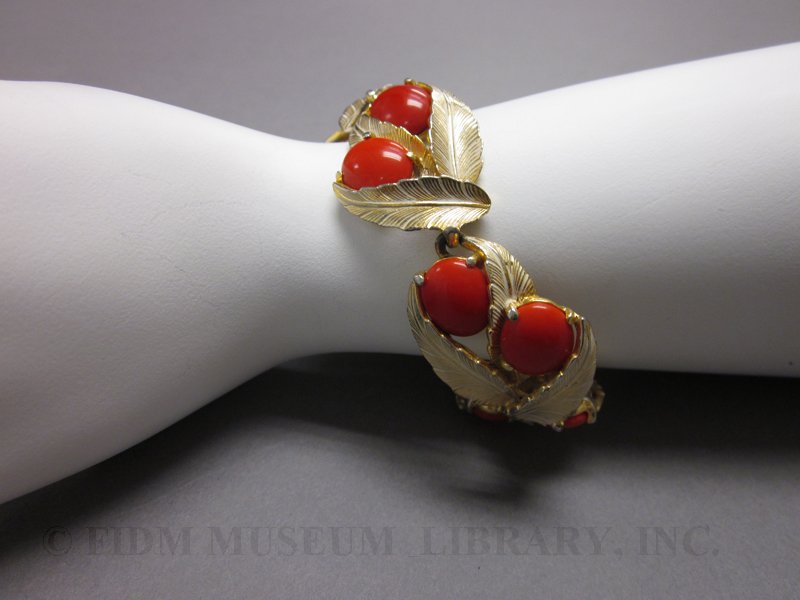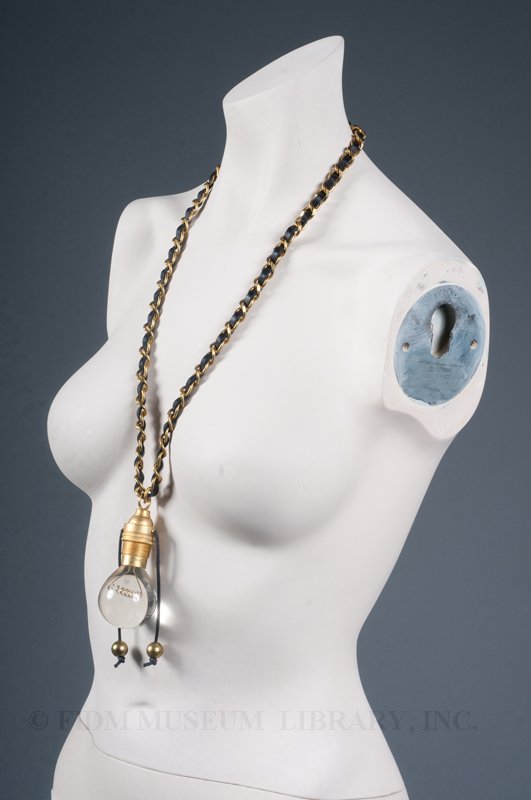Today's post investigates the costume jewelry associated with two renowned design houses: Schiaparelli and Chanel. As we discussed in our post on Kenneth Jay Lane's starburst brooch, costume jewelry became an important component of fashionable dress during the 1920s. Though it had long been possible to imitate the appearance of gold or precious stones with glass paste or pinchbeck, beginning in the 1920s it was acceptable to flaunt jewelry made from inexpensive materials like glass, plastic and non-precious metals. In 1923, the New York Times noted a recent proliferation of shops devoted to costume jewelry, "all displaying a bewildering layout of necklaces, pendants, earrings, bracelets, [and] brooches" made from semi-precious stones and other inexpensive materials.1 Popularized by Parisian couturiers like Patou, Chanel and Schiaparelli, inexpensive costume jewelry soon adorned even those women who could afford the real thing.
Couturiers did more than simply promote costume jewelry. Many couturiers, including both Chanel and Schiaparelli, were closely involved in the design of costume jewelry to complement their haute couture collections. By designing jewelry to complement a particular collection, couturiers ensured that their clients' accessories and dress were aesthetically aligned. Offering branded products like perfume and costume jewelry also promoted the namesake couturier. These less-expensive products also brought the glamour of the haute couture within reach of the less-affluent consumer, who could possibly purchase a necklace or fragrance from Chanel or Schiaparelli, but not an entire ensemble.
 Bracelet
Bracelet
c. 1955
Schiaparelli
Gift of Barbara Bundy
2006.37.10
The bug necklace is Schiaparelli's most iconic piece of costume jewelry. Designed to accompany the Fall 1938 Pagan collection, the collar-like necklace is comprised of a sheet of transparent plastic decorated with brightly colored bugs. Because the base is transparent, the bugs seem to crawl on the wearer's neck. Other whimsical and surreal pieces of Schiaparelli costume jewelry include a brooch in the shape of a mussel shell, a necklace made from multi-colored metal rosebuds and a zodiac themed necklace to accompany the 1937 Zodiac collection. Schiaparelli worked closely with a variety of designers to create jewelry that resonated with each collection. Her jewelry collaborators included Jean Clement, a trained painter, and Jean Schlumberger, who would go on to design jewelry for Tiffany & Co.
Though Schiaparelli was closely involved in the jewelry that accompanied her haute couture showings, she also licensed her name to the production of costume jewelry. These pieces were endorsed by Schiaparelli, but she probably had little to no involvement in the design process. By the early 1950s, Schiaparelli's licensed products, including jewelry and perfume, were supporting her foundering haute couture business. When Schiaparelli closed her house in 1954, licensed products bearing her name were manufactured for a few more years. The licensed Schiaparelli bracelet above, though not designed by Schiaparelli herself, suggests the enameled metal foliage necklaces created for her 1938 Pagan Collection. The dramatic styling of this bracelet is typical of 1950s costume jewelry, which often featured faux gems placed in ornate gilt settings.
 Necklace
Necklace
Spring/Summer 1994
Karl Lagerfeld for Chanel
Gift of Dorothy Washington Sorensen
2010.1110.67
Gabrielle Chanel is generally credited with introducing the idea of costume jewelry to high fashion. In 1924, she designed a pair of striking faux pearl earrings–one white, the other black. Soon afterwards, she introduced a pearl choker, versions of which were featured in Vogue no less than 5 times.2 These experiments with patently fake pearls, previously one of the most costly jewels, upended the previously held notion that fake jewels were unworthy of society ladies. Chanel's ornaments of non-precious metals and gems were greatly admired, valued for their design merit, not their material worth.
Like Schiaparelli, Chanel collaborated with artists and designers to create her jewelry. Well-known collaborators included Paul Iribe, known for his textile designs, and Fulco di Verdura, who would later found his own line of costume jewelry. Though Chanel is most closely associated with fake pearls, she also favored oversized Maltese crosses incorporated into large cuff bracelets or brooches and necklaces made of faceted glass stones set-in gilt metal.
This necklace, which is almost in the spirit of Schiaparelli's surrealism, was created by Gabrielle Chanel's second successor, Karl Lagerfeld. Since taking over the House of Chanel in 1983, Lagerfeld has systematically reinterpreted his predecessor's sartorial trademarks. This eclectic necklace features a realistic incandescent acrylic light bulb; the mundane household fixture is transformed into a flashy, postmodern fashion statement when draped around a woman's neck. The leather and metal links reference the straps of Chanel's classic quilted purse, introduced in 1955, which were in turn inspired by the chains used to weight the hems of her impeccably tailored jackets.3 Lagerfeld constantly reinvents his brightest ideas; in 2011, he designed pumps with high-heels made of functioning light bulbs.
Want to see this lightbulb necklace for in-person? It will be on exhibit in FABULOUS! through December 17, 2011. Or purchase your own copy of the catalogue from the FIDM Museum Shop.
1 "Beads In Vogue As Ornaments" New York Times 18 Nov. 1923: X10.
2 Milbank, Caroline Reynolds. "The Elements of Style: Chanel's Accessories" in Harold Koda and Andrew Bolton. Chanel (New York: The Metropolitan Museum of Art and Yale University Press, 2005), 27.
3 Ibid., 28.

